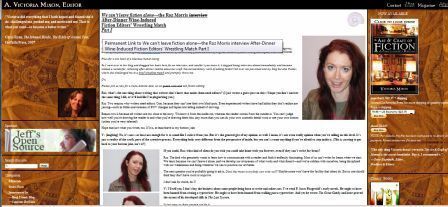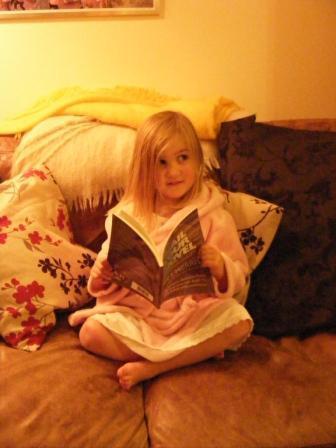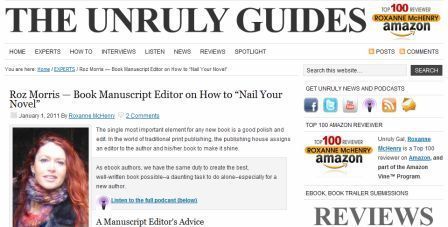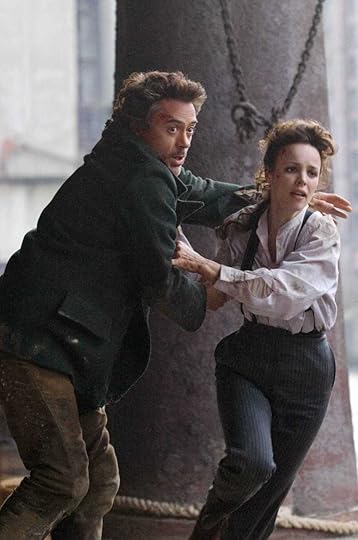Roz Morris's Blog, page 114
January 24, 2011
'We can't leave fiction alone' – on the couch with editor Victoria Mixon, figuratively speaking…
 Victoria Mixon is probably the most hilarious book doctor in the world. Rascally and razor sharp, weird and wise. I'm surprised clients don't suffer creative aneurysms. She's the author of The Art & Craft of Fiction, A Practitioner's Manual, and her blog was rightly voted one of the top 10 writing sites in the Write To Done awards (in which Nail Your Novel was a runner-up). To celebrate, she decided she wanted to interview me, God bless her.
Victoria Mixon is probably the most hilarious book doctor in the world. Rascally and razor sharp, weird and wise. I'm surprised clients don't suffer creative aneurysms. She's the author of The Art & Craft of Fiction, A Practitioner's Manual, and her blog was rightly voted one of the top 10 writing sites in the Write To Done awards (in which Nail Your Novel was a runner-up). To celebrate, she decided she wanted to interview me, God bless her.
Head on over to her place where we had, in her words, 'a rollicking after-dinner ramble about our craft and the extraordinary work of editing fiction…' Plus some silliness…








January 22, 2011
3 fixes to make your first novel fly: part 3 – don't be linear

A good story keeps moving the goalposts
The middle of a story is often problematic. The writer has realised that real meat is needed between the bread of the beginning and the bread of the end. They do the logical thing – break the journey into several stages that gradually reach the goal.
That's definitely an improvement, but it's usually too predictable.
A story needs ups and downs, twists and turns. If a story is a straightforward journey from A to B and finally to Z, that's hardly worth telling. It's known as a linear plot – and is about as entertaining as a set of instructions for building a bookshelf.
So what gives a story those twists and turns? In a word, the answer is change – within the story and the characters.
Fix 3, part 1: move the goalposts
Characters should start out with a goal, but a good story keeps moving the goalposts.
Here's an example. A character starts off thinking she wants a job on a magazine. She gets it – and it's shallow and bitchy. Change one – it's not what she thought. What might she do then? She needs the money so she puts up with the misery, but it's affecting her relationships with friends and family. She hates it more. But something happens to show her a facet of it that she likes, and then she starts to embrace the world. Change two – she's not just fitting in, she's sacrificing her integrity. Now she might have another aim – to become queen bee. And so on, down the slippery slope… (This is loosely based on Lauren Weisberger's The Devil Wears Prada)
Moving the goalposts like this makes the story really come alive and develop a pulse of its own.
Of course, there has to be some unity in the end, so that the finale seems to arise from what happened at the start. The character can even end up getting what she wanted right at the start. But she will do it as a different person, who has learned where she really fits and what matters – and it will feel well earned and true.
Fix 3, part 2: add a sub-plot
A novel also needs more than one story. This is where the sub-plot comes in. Sub-plots do all sorts of wonderful things. They allow you to explore your theme from another angle, at a stroke making your story more complete and complex. They also give you a chance to hop to another strand of story to vary the pace or the tone – or to keep a cliff-hanger screeching a little longer.
Ideally they will interweave with the main plot at some stage and might even merge to join it. Even in a first-person narrative, where you're focussing just on that character's goals, there should be a way of getting a subsidiary story in.
A lot of first novels I see are afraid to get messy with the plot. It is as if the writer sees a target at the end of the book and is afraid to take their eye off it. But what you do between the start and the finish is the story.
So, to recap (and thank you for the picture, ContentAction on Flickr)
My 3 fixes to make your first novel fly
Hook the reader with head AND heart
Give the story a middle
Set goals and keep moving the goalposts








January 20, 2011
3 fixes to make your first novel fly: part 2 – give your story a middle
 There are three problems I commonly see when writers first attempt a novel. Last post I discussed failing to hook the reader. The other two are plotting problems. Today, I'm looking at …. The missing middle
There are three problems I commonly see when writers first attempt a novel. Last post I discussed failing to hook the reader. The other two are plotting problems. Today, I'm looking at …. The missing middle
There's an old saying that stories have a beginning, a middle and an end. In many of the manuscripts I see it's clear the writers planned the start and the finish. But often there is nothing in the middle.
That doesn't necessarily mean they're too short. Au contraire, I see a lot of manuscripts that bravely rack up several hundred pages between the first incident and the last. Much of this seems to be aimless noodling until the spark catches and we're into the climax.
For instance, a girl gets a job as PA to a glamorous film star and spends a lot of the book talking to her friends, and hanging out with Target Man on a professional basis. But nothing develops for three-quarters of the book until she's thrown out of Camelot – which then kicks off a perfectly creditable rollercoaster to the end. I can feel the writer keeping the characters milling about the set until she's ready to unleash them on the purposeful bit. I can also feel her boredom as she tries to find ways to keep them amused until the part she really wants to write.
But every step the story makes should be purposeful. Don't mark time in the middle. In fact, don't even think of a middle. Think instead of a series of steps, each of them significant, which changes something and causes what happens next.
In those novice manuscripts, I could precis the middle into a few short pages and then zip straight to the end. It shouldn't be like that. The parts between the beginning and the end should be necessary.
Thank you TMAB2003 on Flickr for the photo. I originally intended this to be two posts, but it ran away with itself. And so you will very soon get a part 3 – the other major novice plotting problem… stay tuned…
Do you find middles tricky?








January 17, 2011
Wearing my interview hat at We Do Write
 Dorothy Dreyer, of the blog We Do Write, has invited me to her virtual home today. Dorothy's blog is an exciting concept – she grabs writers of the future as they pen their debuts. Although I'm a bit of an odd case as I'm an old-timer on the bookshelves, I've only recently come out from under the ghostwriting sheet with novels of my own and so I'm excited to be asked.
Dorothy Dreyer, of the blog We Do Write, has invited me to her virtual home today. Dorothy's blog is an exciting concept – she grabs writers of the future as they pen their debuts. Although I'm a bit of an odd case as I'm an old-timer on the bookshelves, I've only recently come out from under the ghostwriting sheet with novels of my own and so I'm excited to be asked.
Anyway, she's asked me to talk about My Memories of a Future Life, the novel I have on submission, as well as ghostwriting, my biggest tip for writers as I wade through a rather challenging WIP – and what's on my desk as I pound the keys. Plus she set me a fiendish writing challenge. Read more here.
And part 2 of the post on first novel fixes will be up before the week is out…








Gremlins hit Nail Your Novel Amazon listing – but you can buy from Lulu or from me direct

You're never too young to start; my god-daughter, Eliza Wallis, reads Nail Your Novel. No, she's not the gremlin that caused all the trouble (at least not this time)
I just received an email from a reader who couldn't find the listings to buy Nail Your Novel - and discovered it has disappeared from Amazon.
After a good bit of hair tearing and digging in the Lulu help forums, I discovered Lulu has made 'service improvements' and many customers are up in arms because their Amazon listings have been unavailable for a week. Not only that, Lulu had somehow (and unforgivably) turned my listing to private access so that nobody could buy it.
So – if you've been trying to buy Nail Your Novel, or browse it on Amazon, I'm sorry you've had a frustrating time. The Lulu listing is now working - here it is – and I am shouting at them to get the Amazon one back. Not to mention my 13 five-star reviews, which you guys have written and I'm terribly grateful for – and would be gutted to lose.
You can still use the Bookbuzzr widget to read the first 15 pages (see the column on the right) and the link from there will now take you to Lulu. And if all else fails, I have some copies and will happily sell to you via Paypal (and you'll get a cute little Nail Your Novel Moo card to use as a bookmark – although I'm afraid my cute little god-daughter is not included).








January 16, 2011
3 fixes to make your first novel fly: 1 – hook your reader by the head AND the heart
 Over the next 2 posts I'm going to look at 3 common problems I see in first novel attempts. Today I'm dealing with possibly the most important. How you hook the reader.
Over the next 2 posts I'm going to look at 3 common problems I see in first novel attempts. Today I'm dealing with possibly the most important. How you hook the reader.
This week I've seen a number of posts by writers looking back on what they wish they'd known when they embarked on their first novels – literary agent and writer Weronika Janczuk and writer Krista Van Dolzer. Speaking with my editing hat on, I find there are three major problems that crop up time and time again in the manuscripts of first-time writers – so I thought I'd talk about them here.
Today, I'm going to talk about hooking the reader.
No one is obliged to finish your book – or even read beyond the beginning
When we're at school we're taught that if we start a book we must read it all the way to the end. It's usually a rite of passage when we decide we won't respect that rule any more, but once we do, we never again stay with a book out of polite duty. We need to be made to read on.
Quite often, first-time novelists have thought of a story, but not about how they will actively reach out to the reader and persuade them to pay attention. They need to approach this on two levels – intellectually and emotionally.
Creating intellectual curiosity
You can reach out with mystery, intrigue, drama, comedy, and atmosphere. Perhaps a body is found in a mysterious situation; a noise is heard every night at a particular time that can't be explained; a girl fancies the guy who's going out with her best friend. These hooks generate curiosity, so that the reader thinks, what is going on, what will happen next, what is the answer?
But that's the easy bit – comparatively.
Creating the emotional connection – engagement
This is much harder and a lot of first manuscripts miss this element. Good stories have a bolt of emotional recognition that binds the reader to the characters. They put you in the characters' shoes.
 Perhaps she is Everygirl, like the MC in the opening of Alice Sebold's The Lovely Bones:
Perhaps she is Everygirl, like the MC in the opening of Alice Sebold's The Lovely Bones:
'My name is Salmon, like the fish; first name, Susie. I was fourteen when I was murdered on December 6, 1973. In newspaper photos of missing girls from the seventies, most looked like me: white girls with mousy brown hair…'
Sebold goes on to sketch a picture of a recognisable schoolgirl – good at some subjects, disastrous at others, who is just discovering the wider world. These details are not just scene setting, they are the emotional link to who she is – an ordinary girl like us, who was robbed of the chance to grow up.
Here's another example, the opening of Marcus Sedgwick's Revolver:
'Even the dead tell stories.
Sig looked across the cabin to where his father lay, waiting for him to speak, but his father said nothing, because he was dead.'
With these few deft words, we're in Sig's shoes.
You don't necessarily have to launch straight in with the plot. One of my favourite openings is F Scott Fitzgerald's short story The Cut Glass Bowl:
There was a rough stone age and a smooth stone age and a bronze age, and many years afterward a cut-glass age. In the cut-glass age , when young ladies had persuaded young men with long, curly moustaches to marry them, they sat down several months afterward and wrote thank-you notes for all sorts of cut-glass presents… After the wedding the punch-bowls were arranged on the sideboard … the glasses were set in the china closet … – and then the struggle for existence began. … the last dinner glass ended up, scarred and maimed, as a toothbrush holder…
It's brilliant, a timeline for a marriage seen through a couple's wedding presents, and so human. We don't know who the characters are yet and we haven't a clue what they are going to do. But on a different level, we know them very well. We feel connected to their problems and their dramas – and we want to read on.
Many first-time writers think about grabbing the reader intellectually – from the outside – but not from the inside. It needs just as much attention – if not more.
Part two of this post will discuss two simple plotting problems that I often see in first novels
In the meantime, thanks to Ell Brown on Flickr for the photo – and guys, share the novel openings that really engage you!








January 10, 2011
How to get ideas for stories – be gullible

Be open to oddness: BBC TV Panorama's infamous April fool hoax, the spaghetti trees of 1957
How do you get ideas for stories? Here's one trait I'm sure keeps my ideas machine ticking away
I am hopeless at spotting a fib. The other day I was at the hairdresser having the red refreshed. Instead of my usual contact lenses I was in glasses, which have to come off while my locks are being daubed. I was listening in a thick myopic fog while my hairdresser, who is Spanish, was telling me about Christmas traditions in Madrid. They were quite charming and I repeated them in wonder: you put out gifts on January 6th for the Three Kings, including water for their camels? Wow – I love that.
She might have been kidding, but I would never have seen any ironic winks or smiles because I couldn't see beyond my own eyelashes. The rest of the stylists in the salon and their clients might have been sniggering through their capes, agog for what I would believe next. If they were, I don't mind. I was having a great time because I liked the story.
I have always been hopeless at spotting a fib. If you tell me something whacky that sounds interesting, I will find a reason why it is plausible. So a glass of water left out for the Wise Men's camels makes perfect sense to me, because it has story logic, and in my head I've joined the narrative dots.
As storysmiths, the extraordinary, the ironic and the surprising are our currency. Part of our job is to invent the logic that gets from A to bizarre – or the other way around. Good stories are about big changes, interesting journeys, the unexpected.
If a straitlaced friend tells me she has taken up burlesque dancing, the last thing on earth I'd say is 'you're joking'. I'd swallow it because I'd think what a surprising and refreshing turn her life has taken, how wonderful it is that she has conquered her stage fright, shyness, objections to female exploitation and previously voiced disapproval of skimpy feathered costumes. I will think: 'she must have needed it – I wonder why?'
So I am A1- gullible. But I've far outgrown being embarrassed by it. It's served me well as source of stories.
Do you value the strange? Have any personality traits that may seem laughable or embarrassing, but that you feel help you as a writer? Share in the comments!








January 8, 2011
Write and finish your novel in 2011 – guest podcast on Unruly Guides
 Is your new year resolution to write your novel? Perhaps you've vowed to dust off your NaNoWriMo experiment and finish it properly, or to do justice to the idea you started a while ago and had to put aside. If so, I have something for you! Roxanne McHenry of Unruly Guides to epublishing invited me on their podcast show recently, and asked me for my advice on drafting, revising and seeking feedback.
Is your new year resolution to write your novel? Perhaps you've vowed to dust off your NaNoWriMo experiment and finish it properly, or to do justice to the idea you started a while ago and had to put aside. If so, I have something for you! Roxanne McHenry of Unruly Guides to epublishing invited me on their podcast show recently, and asked me for my advice on drafting, revising and seeking feedback.
In this podcast you can get advice on:
planning your novel and filling in the plot holes
revising your manuscript effectively and thoroughly
keeping your motivation
solving problems in your story
finding a critique group that's right for you
when – and whether to hire a profesional editor – and how to find one who is a good fit for you.
Here's a sample of our discussion: 'If you're going to go along to a critique group, take along a short story, where you don't mind what they say, and just see how they deal with your writing before you unleash the novel that really matters.'
You can listen to or download the whole podcast here – hope to see you there!








January 6, 2011
Yikes, new design!

Still nailing - thank you mskogly
Yes, you have reached Nail Your Novel. It's a new year, and my internet access has at last been properly restored – two irresistible excuses for giving the blog a new outfit. And I'll be able to answer your comments a bit more promptly instead of having to wait until an unreliable mifi dongle deigns to catch a wisp of signal.
In the meantime, thanks to all of you who commented on my holiday posts, and were patient with the apparent unresponsiveness of your host. I look forward to chatting with you at more relaxed length – and hope you find this new design as readable as the old one. Proper new post on Monday!








January 3, 2011
New Year special – writing sins that scupper a story Part 5: Sherlock Holmes
 Over the last few days I've railed about weak story links, lazy plotting, wrong point of view, bad characterisation and unsatisfying endings in DVDs I've watched over the holidays. Yesterday I had a chewy moan about hasty rewrites that weren't properly integrated in Did You Hear About The Morgans. Today's post is not a complaint, but a congratulation. It features a film where I suspect a major change had to be made, but it was done deftly and without upsetting the story. So beware spoilers, and I give you…
Over the last few days I've railed about weak story links, lazy plotting, wrong point of view, bad characterisation and unsatisfying endings in DVDs I've watched over the holidays. Yesterday I had a chewy moan about hasty rewrites that weren't properly integrated in Did You Hear About The Morgans. Today's post is not a complaint, but a congratulation. It features a film where I suspect a major change had to be made, but it was done deftly and without upsetting the story. So beware spoilers, and I give you…
Sherlock Holmes - and the mystery of Irene Adler's trousers
It all started when Irene Adler had to be rescued from the slaughterhouse and was found to be wearing voluminous men's trousers – which you have to admit is unusual attire for a lady of the Victorian era. Was it a disguise? We were never told.
Writing sin (very venial): A rather too crowded final scene
That wouldn't have bothered me much, as she's a racy lady who likes to cut a dash – but for a rather crowded final scene. Right at the end of the movie, Holmes is explaining to Watson and his fiancée how the villain Blackwood faked his death, when some policemen rush in with news that the explosive device defused in the story's climax has been stolen. This info-dump is quite substantial and completely upsets the rhythm of the dialogue (so that Watson's fiancée appears to be kneeling on the floor for a very long time). My hypothesis?
The arrival of the police been spliced in to prime the audience for a sequel with Professor Moriarty.
Of course, a hunch like that isn't enough, and Dave soon provided the next clue. Many moons ago, he saw a trailer for Sherlock Holmes that featured a scene where Irene knees Holmes in a sensitive place. It wasn't in the final film. And he read on imdb that the release of Sherlock Holmes was delayed because more edits were needed.
Could someone have made a decision at a late stage to lay the groundwork for a sequel with Moriarty?
We looked at the movie again. There were a number of scenes where Irene meets a shadowy figure in a darkened carriage. They could all have been spliced in later, with deft reshoots and editing. And as commercial movies have to keep to a strict length, other story material must have gone. Was the missing fight between Irene and Holmes evidence that something had been removed?
And was Irene's male attire originally a disguise, from a story thread that hit the cutting room floor?
When revising, we often have to slip in new elements or change an emphasis. This might be because we've changed our direction or because of outside feedback. If it's late on in editing, the amount of unpicking required is enough to make you reach for the violin or the opium pipe.
Maybe my theory is totally wrong. But if you're trying to knit a new thread into your story, get the DVD of Guy Ritchie's admirable Sherlock Holmes, imagine it doesn't have the Moriarty thread – and see how they made it look as though it was always there.
Have you had to splice new threads or ideas into a book? Was it painful and how did you do it?











